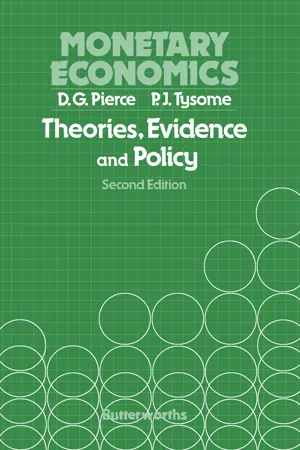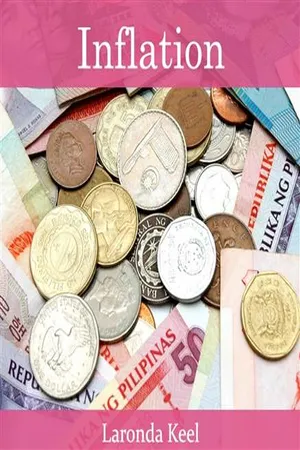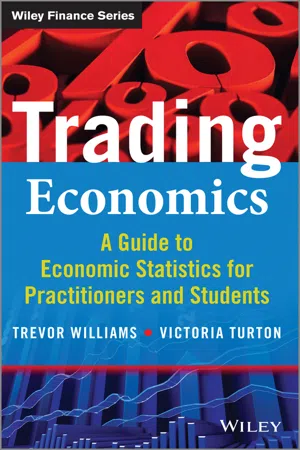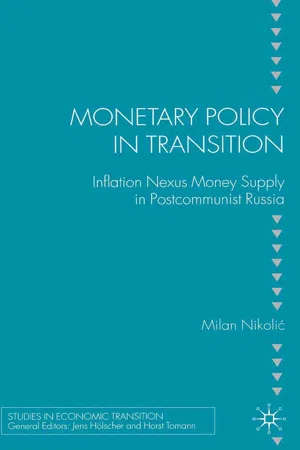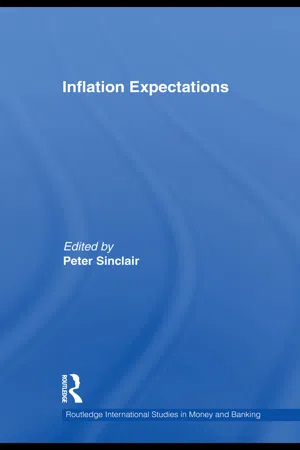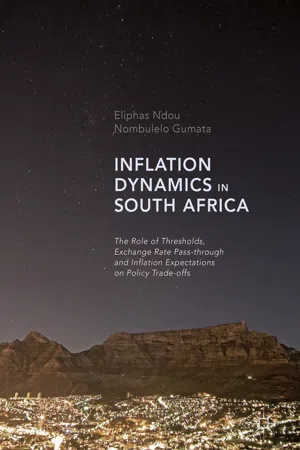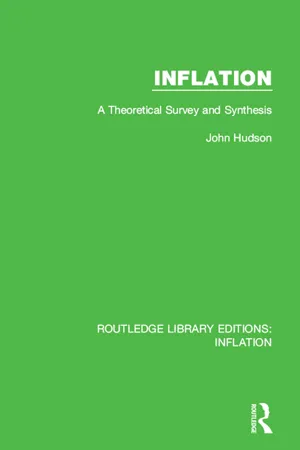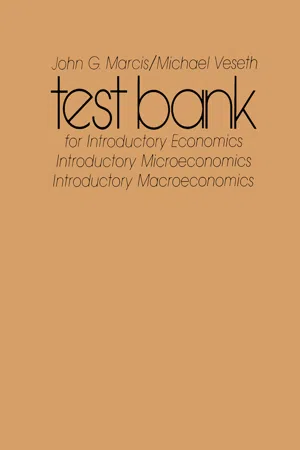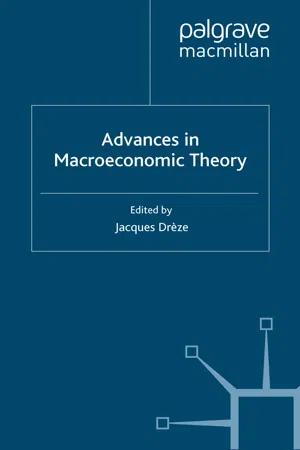Economics
Expected Inflation
Expected inflation refers to the anticipated rate at which the general level of prices for goods and services is expected to rise over a specific period. It is a key factor in economic decision-making, influencing investment, borrowing, and spending. Expected inflation is often used in economic models and policy discussions to assess its impact on various aspects of the economy.
Written by Perlego with AI-assistance
Related key terms
1 of 5
10 Key excerpts on "Expected Inflation"
- eBook - PDF
Monetary Economics
Theories, Evidence and Policy
- David G. Pierce, Peter J. Tysome(Authors)
- 2014(Publication Date)
- Butterworth-Heinemann(Publisher)
73-74. In this context it means that inflation expectations are adapted (i.e. revised) whenever actual inflation rates differ from those that had been expected. Thus if inflafion is expected to be at a rate of 15%, but actually turns out to be 20%, then people will revise upwards their expectafions Market theories of inflation 205 of inflation for the next period. It is possible that expectations are always adjusted by the whole of the difference between Expected Inflation and actual inflation, which is only another way of saying that the inflationary expectations of the current period are always equal to the actual inflation of the last period. More generally, expectations are seen as being adjusted by some fraction of the gap (i.e. expectation error) that arises whenever the actual rate of inflation turns out to be different from the rate expected. This may be written / f -/ f _ i = 6 ( Á _ , -P f _ , ) 0 < & < l (9.4) This is equivalent to (see p. 73) Pf = bP,_, + 6(1 -b)P ,_2 + i>(l -bfP,_, +... (9.5) This is a geometrical progression so that current inflation expectations are equal to a geometrically weighted average of past rates of inflation. The weights decline geometrically over earlier and earher time periods: this simply means that people are seen as giving greater emphasis to the more recent past when forming their inflationary expectations. How rapidly the weights decline depends on the relative importance attached by economic agents to the recent rather than the earlier history of actual inflation rates. The weights in equation (9.5) sum to unity so that a constant rate of inflation will eventually result in equality between the actual and Expected Inflation rates. If however, inflation is accelerating or highly volatile then equation (9.5) would generate forecasts which were very inaccurate. The other approach to 'measuring' is to attempt a direct estimate by using the data generated by questionnaire-type surveys. - No longer available |Learn more
- (Author)
- 2014(Publication Date)
- Orange Apple(Publisher)
____________________ WORLD TECHNOLOGIES ____________________ Chapter- 1 Inflation In economics, inflation is a rise in the general level of prices of goods and services in an economy over a period of time. When the general price level rises, each unit of currency buys fewer goods and services. Consequently, inflation also reflects an erosion in the purchasing power of money – a loss of real value in the internal medium of exchange and unit of account in the economy. A chief measure of price inflation is the inflation rate, the annualized percentage change in a general price index (normally the Consumer Price Index) over time. Inflation's effects on an economy are various and can be simultaneously positive and negative. Negative effects of inflation include a decrease in the real value of money and other monetary items over time, uncertainty over future inflation may discourage investment and savings, and high inflation may lead to shortages of goods if consumers begin hoarding out of concern that prices will increase in the future. Positive effects include ensuring central banks can adjust nominal interest rates (intended to mitigate recessions), and encouraging investment in non-monetary capital projects. Economists generally agree that high rates of inflation and hyperinflation are caused by an excessive growth of the money supply. Views on which factors determine low to moderate rates of inflation are more varied. Low or moderate inflation may be attributed to fluctuations in real demand for goods and services, or changes in available supplies such as during scarcities, as well as to growth in the money supply. However, the consensus view is that a long sustained period of inflation is caused by money supply growing faster than the rate of economic growth. Today, most mainstream economists favor a low steady rate of inflation. - eBook - PDF
A Concise Guide to Macroeconomics, Second Edition
What Managers, Executives, and Students Need to Know
- David Moss(Author)
- 2014(Publication Date)
- Harvard Business Review Press(Publisher)
67 C H A P T E R T H R E E Expectations A final topic of great importance in macroeconomics is expecta- tions. Expectations about the future play a pivotal role in every market economy, influencing in one way or another nearly every economic transaction and decision. As we have seen, expecta- tions can drive an entire economy in one direction or another and can even become self-fulfilling. If depositors expect a bank to fail, it very well might if fearful depositors begin pulling their money out en masse. Similarly, for the economy as a whole, expectations of inflation can produce the real thing; and an econ- omy can fall into recession if enough people expect it to falter. These sorts of expectations are of particular interest to macro- economists. The good news is that expectations can push economic reality not only in a negative direction, but in a positive one as well. Understanding the Macro Economy 68 Sometimes these favorable expectations emerge on their own. At other times, many macroeconomists believe, the government has to help cultivate them. In fact, managing expectations may well be the most important function of macroeconomic policy, both monetary and fiscal. Expectations and Inflation Naturally, neither firms nor individuals want to come out on the losing side of inflation. If workers expect consumer prices to rise in the months and years ahead, they will likely demand higher wages to ensure that their real incomes—that is, their incomes after adjusting for inflation—don’t fall. By the same token, if firms expect wages and other input prices to rise, they are likely to try to raise their prices to ensure that their earnings don’t fall. Prices and wages will therefore rise in reality as individuals and firms try to protect themselves against expected price increases. In this way, expectations of inflation can powerfully drive reality. - eBook - PDF
Trading Economics
A Guide to Economic Statistics for Practitioners and Students
- Trevor Williams, Victoria Turton(Authors)
- 2014(Publication Date)
- Wiley(Publisher)
4 Inflation Inflation is always and everywhere a monetary phenomenon in the sense that it is and can be produced only by a more rapid increase in the quantity of money than in output. Milton Friedman 1 WHAT IS INFLATION? Inflation tells us the changing (increasing) price of a range of goods or services; basically how much of something we can get for our money. The rate of change of prices – the speed at which the price of goods and services that are bought by households or businesses alter – is called inflation. But prices can also fall, in a process called deflation, sometimes termed negative inflation. Inflation is more common than deflation, or at least it has been in the last 50 years or so, and so it has become associated with changes in the price of goods and services. Historically, however, price falls were as common as price rises, as we will see later. Both inflation and deflation have advantages and disadvantages, which we will explore in more detail later in this chapter. THE HISTORY OF INFLATION Inflation has been around for a long time, but, as Figure 4.1 shows, the level of prices (the index) really only rose consistently and sharply in the UK from the 1970s onwards. This was after the US came off the gold standards and the Bretton Woods system of fixed exchange rates, which had prevailed after the Second World War, ended. Money was now backed by government fiat and trust rather than by gold. And exchange rates were no longer fixed but allowed to float freely. This seems to have led to a rapid rise in the level of prices or, in other words, to the Retail Prices Index. Before that, for hundreds of years, the level 1 Friedman, M., The Counter-Revolution in Monetary Theory (1970). 100 Trading Economics Retail Price Index (1987 = 100) 0 10 20 30 40 50 60 70 80 90 100 1264 1296 1328 1360 1392 1424 1456 1488 1520 1552 1584 1616 1648 1680 1712 1744 1776 1808 1840 1872 1904 1936 1968 2000 Figure 4.1 Price index over time. - eBook - PDF
Monetary Policy in Transition
Inflation Nexus Money Supply in Postcommunist Russia
- M. Nikolic(Author)
- 2006(Publication Date)
- Palgrave Macmillan(Publisher)
For example actual inflation exceeded expectations in over 70 per cent of the surveys conducted in the period 1947-73. This poor predictive power was demonstrated by a low R2, which did not exceed 30 per cent, and the large constant term of 2.05 per cent (ibid.). With regard to the rationality of the Livingston data, opinions differed. While many researchers found that the data were consistent with rationality (for example Turnovsky, 1970; Mullineaux, 1978, 1980), others rejected the REH even in its weak form, except for the specific period 1957-71 (for example Pesando, 1975; de Menil and Bhalla, 1975; Carlson, 1977; Holden and Peel, 1977; Figlewski and Wachtel, 1981).4 In contrast to market economies, where the formation of both consumers' and producers' inflation expectations have received consid- erable attention, the topic has sparked little interest in transition economies. Although inflation expectations are not at the core of their analyses, Hoggarth (1996), Allen et al. (1996), Korhonen and Pesonen (1998) and Nikolic (2000a) have all found that one -month lagged infla- tion is among the most important determinants of inflation in the Russian economy. Quite the reverse has been found for transition economies as a whole by Cottarelli et al. (1998) and Coorey et al. (1998). The scant interest in the topic in transition economies can perhaps be explained by the lack of experience with open inflation in the majority of these economies, the lack of survey data on expectations of inflation and the unavailability of financial and time series data of inflation. In the absence of means of independently measuring expectations, we postulate a scheme for generating expectations in terms of observable variables. First, however, a brief description of the history of inflation in postcommunist Russia is in order. In the presence of a monetary overhang, the liberalization of prices on 2 January 1992 was bound to cause an explosion in prices. - eBook - ePub
- Peter J. N. Sinclair, Peter J N Sinclair(Authors)
- 2009(Publication Date)
- Routledge(Publisher)
The quest for a microfounded theoretical and simple model of inflation dynamics has recently gone far beyond the sticky-price setup. Mankiw and Reis (2002) suggest that—because of costs of acquiring information and/or of price reoptimization—pricing decisions are not always based on current information. Hence current inflation depends on output (as a measure of demand conditions) and past expectations of current inflation and output growth. They call the resulting equation the sticky-information Phillips curve.This sticky-information approach goes beyond the scope of this chapter, as it includes not only inflation expectations, but also output growth expectations. However, there is one important input here, developed further by Reis (2005) and Sims (2005), suggesting that the process of acquiring and processing information that is an important part of forming inflation expectations by economic agents should be in itself treated as an outcome of rational (optimizing) behaviour. This has serious implications for the traditional understanding of rationality of surveybased inflation expectations and the traditional way of testing for this rationality.8 They may be summarized here as giving strong support to the idea of using agents’ inflation expectations directly when modelling inflation dynamics within the Phillips curve framework (Section 3 describes this in greater detail).2 Survey measures of inflation expectations
There are two major problems to be solved before applying direct measures of inflation expectations in inflation modelling. The first is the choice of type of agents who are surveyed. Most studies use either surveys of professional forecasters or household (consumer) surveys.9 - eBook - PDF
Inflation Dynamics in South Africa
The Role of Thresholds, Exchange Rate Pass-through and Inflation Expectations on Policy Trade-offs
- Eliphas Ndou, Nombulelo Gumata(Authors)
- 2017(Publication Date)
- Palgrave Macmillan(Publisher)
This may point to the prevalence of inflation indexed labour contracts which last for multiyear periods, which is normally three years in the case of the public sector. Based on evidence, such cyclicality aspects are pronounced due to the feedback of transitory inflation shocks on wage indexation. In policy terms, allowing inflation expectation to remain high has the unintended consequences that policy initiatives may not be able to anchor wage growth within the inflation target band. This does not mean it is impossible to achieve sustainable desirable inflation outcomes and well- anchored inflation expectations. It requires policymakers to engage on a persistent drive of “moral suasion” with price setters to discourage the perpetual behaviour of wage indexation outside the inflation target band. Changes in current inflation expectations impact the one- and two- year-ahead inflation expectations. Based on constrained discretion and 498 Inflation Dynamics in South Africa considering the lag length involved in the policy transmission, it may indeed be necessary for monetary policy to anticipate and move in advance of inflationary developments. If the policy objective is to trigger unexpected revision of agents’ decisions regarding future inflation out- look, it is not unusual that certain times necessitate pre-emptive strikes to neutralise inflationary shocks and pressures. References Anderson, G., & Maule, B. (2014). Assessing the risk of inflation from inflation expectations. Bank of England Quarterly Bulletin, 54(2), 148–162. Appleyard, D. R., Field Jr., A. J., & Cobb, S. L. (2008). International economics (6th ed.). Boston: McGraw-Hills/Irwin. Bernanke, B. S. (2003). Before the money marketers of New York University, New York, New York, 3 February. Leduc, S., Sill, K., & Stark, T. (2002). Self-fulfilling expectation and the inflation of the 1970s: Evidence from the Livingston Survey. Federal Reserve Bank of Philadelphia, Working Paper No. - eBook - ePub
Inflation
A Theoretical Survey and Synthesis
- John Hudson(Author)
- 2016(Publication Date)
- Routledge(Publisher)
Chapter 3 Expectations of InflationExpectations as a concept seem to be growing increasingly important, and much of economic theory is now being rewritten to take explicit account of them. Indeed in future years when economists look back at this era, it may well prove to be that this is seen as the thread that links together much of the work being done, as in a similar manner the rejection of the assumption of perfect knowledge characterises much of the work done in the interwar period. However, this awareness of the importance of expectations is not a new phenomenon. Marshall (1920), for example, was aware of the importance of the concept, although as Shackle (1967) comments, this was not a trumpet he chose to blow too hard. But it was really in Sweden that the importance of expectations in economic theory was first fully appreciated, with the work of Myrdal (1939), amongst others, while in England at about this time Keynes’ General Theory had just appeared, in which expectations are of prime importance.Most of this early work was connected with the effects of expectations, rather than with how they were formed. Keynes, at least, thought that some expectations were closely akin to a random variable, and hence unexplainable, that is, unless a theory of animal spirits can be provided. Since then, and particularly since 1960, a substantial volume of literature has appeared concerned with how expectations are formed. This can be divided into two fairly distinct parts, that dealing with theoretical considerations, and that which is mainly empirical in nature. There has, of course, been some interchange between these two avenues of research, but unfortunately this has not been common, and they have by and large remained separate areas. It is hoped in this survey not only to summarise these two approaches, but to forge closer links between them. - eBook - PDF
Test Bank for Introductory Economics
And Introductory Macroeconomics and Introductory Microeconomics
- John G. Marcis, Michael Veseth(Authors)
- 2014(Publication Date)
- Academic Press(Publisher)
e. economic statistic which describes how real income is related to nominal income. 50. Inflation is generally defined as: (80) a. a decrease in the general level of prices. b. an increase in the prices of selected items. C. an increase in the general level of prices. d. a decrease in the prices of selected items. e. a program which ties wages, values and/or taxes to a price index. 51. Consumers paid $125 for a particular basket of goods and services in 1980 and paid $ 150 for the same basket in 1981. What was the annual rate of inflation between 1980 and 19817(92-94) a. Approximately 17 percent. B. Approximately 20 percent. c. Not enough information has been provided. d. Approximately 117 percent. e. Approximately 120 percent. 52. Consumers paid $34.50 for a particular basket of goods and services in 1970 and paid $52.90 for the same basket in 1977. What was the annual rate of inflation between 1970 and 19777(92-94, Tab. 4-2) A. Approximately 53 percent. b. Approximately 67 percent. c. Not enough information has been provided. d. Approximately 47 percent. e. Approximately 33 percent. 53. Consumers paid $100 for a particular basket of goods and services in 1979 and paid $ 150 for a different basket of goods and services in 1981. What was the annual rate of inflation between 1979 and 19817(92-94) a. Approximately 50 percent. b. Approximately 33 percent. C. Not enough information has been provided. d. Approximately 67 percent. e. Approximately 100 percent. 54. According to Veseth, a price index: (81) a. is a book which firms use to determine prices. B. is an approximate measure of the cost of a fixed market basket of goods relative to the same basket in a base period. c. cannot be computed for an economy because the total number of goods in the economy is so large. d. is an approximate measure of the cost of a market basket of goods relative to another basket of goods in a base period. - eBook - PDF
Advances in Macroeconomic Theory
International Economic Association
- J. Drèze(Author)
- 2001(Publication Date)
- Palgrave Macmillan(Publisher)
Recent research has produced measures of the relative size of these costs and benefits in an economy that suggest that inflation targets between 0 and 2 per cent (bias-adjusted) are optimal. But there are two important caveats. First, to the extent that labour pro- ductivity is increasing on average, there is room to reduce the inflation target. Second, the optimal rate of inflation depends on the mixture of shocks and rigidities to which an economy is subject. Furthermore, a long- run steady rate of low inflation implies fewer nominal shocks and puts pressure on price and wage setters to reduce rigidities. Thus, the optimal rate of inflation may differ somewhat across countries and evolve over time. Notes 1. Examples include Bolivia, Israel and Argentina. 2. The literature on the connection between inflation and growth is large and growing, with less than robust results. Andrés and Hernando (1999) is a recent example. 3. Mishkin (1999) provides a discussion of the recent international experience of various monetary regimes. 4. In their Table 1, Morandé and Schmidt-Hebbel (1999) also identify 34 countries that target primarily money and 36 that target exchange rates. 5. The political economy of monetary policy and the importance of credibility have been widely studied. The research in this area has focused on the impor- tance of a structure in which the central bank is independent of the elected officials in the government. See, for example, Alesina and Summers (1993). With independence of operation comes the need for central banks to be accountable for their performance, usually relative to an inflation objective set by statute or agreement with other branches of government. Cecchetti and Groshen: Understanding Inflation 131 6. Throughout this section, we assume that the measurement of core inflation is a statistical problem associated with the estimation of long-run trend movements in prices.
Index pages curate the most relevant extracts from our library of academic textbooks. They’ve been created using an in-house natural language model (NLM), each adding context and meaning to key research topics.
